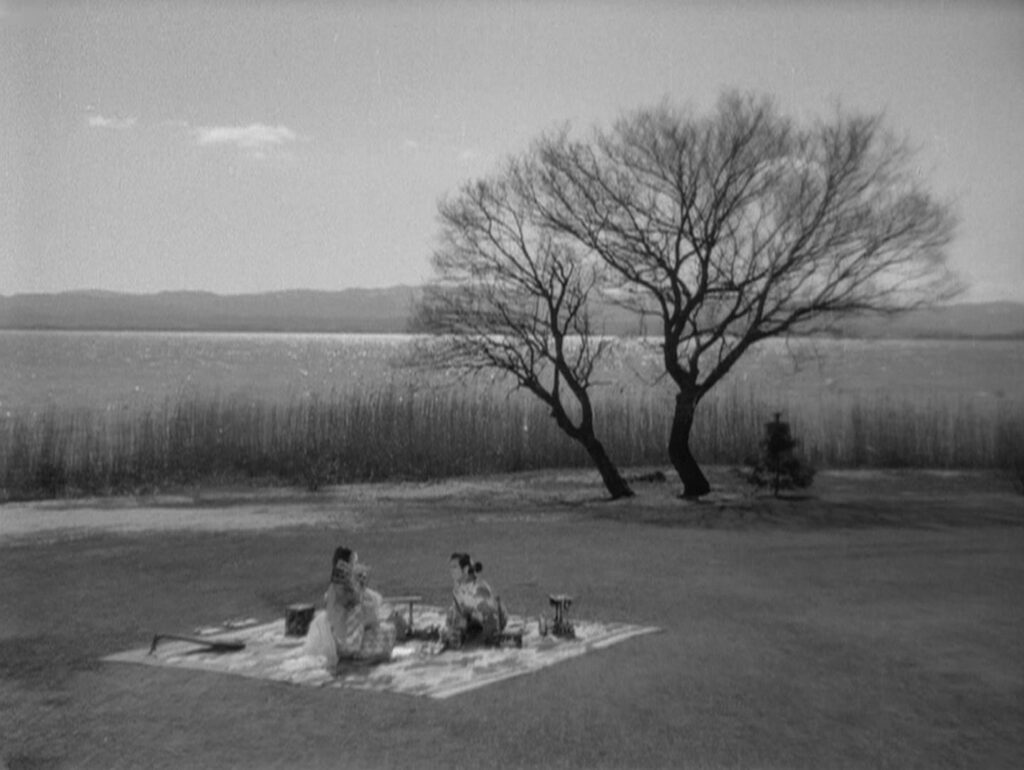
Ugetsu monogatari
1953, directed by Kenji Mizoguchi
About twenty-five minutes into Ugetsu, as the two families flee the fighting in their village, they encounter a dying man on Lake Biwa. Slumped in his boat, the lone traveler warns them of pirates ahead. His warning interrupts the story at an exciting point, just after leaving a bleak, war-ravaged farming settlement to begin a poetic voyage. The boats gliding over the misty lake have all the supernatural air of a ghost story, and the travelers initially take the stranger for a ghost. What happens next violates a cardinal rule of storytelling. Movie audiences will generally accept all sorts of dangers to the characters they follow, even tragedy and loss, but an aborted voyage is hard to stomach. Frightened by the dying man’s warning, the five refugees turn around and return to shore. The diversion lasts only about two minutes, and the journey resumes after they drop off Miyagi and Genichi, but the reversal is jarring.
The boat ride on Lake Biwa is only a small part of Ugetsu, and the movie doesn’t have a lot of traveling scenes, but it does have the arc of a journey. It’s fitting then that it opens with a long pan over the landscape where the two couples live. Horizontal movement primes the audience for the forward flow of a story, and it’s almost a rule for movies to begin with some form of linear progress through time or space. When the characters backtrack on the lake, it’s as if this promised narrative flow has been broken. Of course the damage will soon be repaired as the journey gets back on track, and few viewers will hold a grudge. Nevertheless this momentary setback is neither a flaw nor some unavoidable disruption – in fact it has positive value as a correlative for Ugetsu‘s multidirectional vision of time, looking backwards and forwards simultaneously.
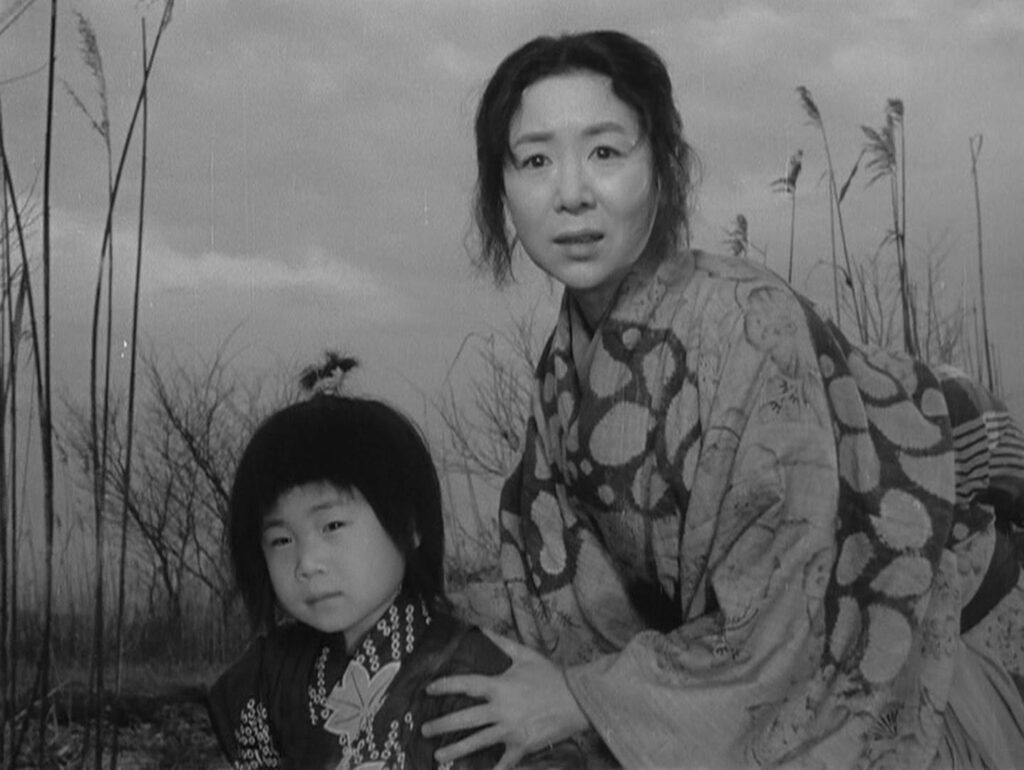
The story of the potter Genjuro looks forward at Japan’s emerging future as a commercial nation, while the subplot about Tobei, the would-be samurai, looks back at Japan’s recent military past. The lessons in both stories have strong parallels, but each is tailored to its respective view of Japan’s place in the 20th century. The 16th century setting puts the lessons at a safe distance, making the argument easier for a contemporary audience to absorb.
Tobei’s wish to become a warrior is portrayed as a childish folly. Chaos and violence were still fresh in Japan’s memory eight years after World War II, and the portraits of the roving soldiers who raid the village, rape Ohama, and kill Miyagi speak to a nation weary of military adventurism. At the same time, audiences would recognize themselves in Genjuro, a farmer who finds new opportunities in industry as he begins to profit from his pottery. One thread looks back at Japan’s mistakes in the war, while the other looks ahead at the mistakes Japan risks making in a time of rising prosperity.
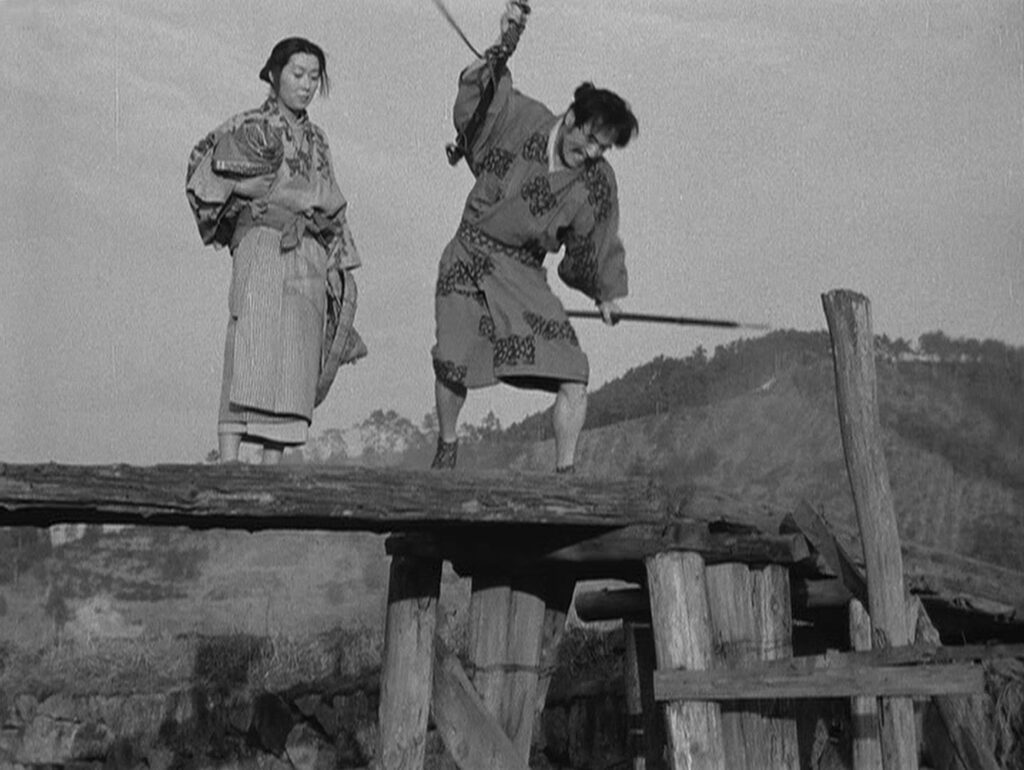
The forward-looking story is naturally the dominant one. Just as the story joins two couples who represent two directions of time, the film also alternates between forward and reverse narrative motion. Again it’s the forward motion that dominates, despite multiple reversals: the return to shore, a cut back to the village for Miyagi’s death, and Genjuro’s ultimate return. The present and its hopes for the future may dominate, but the past always haunts it from the background. Genjuro’s error is to be seduced by phantoms from the past. Lady Wakasa, a ghost from a bankrupt aristocratic family, represents a lost Golden Age, and Genjuro’s attraction to her is regressive both historically and psychologically. When he wakes up in the ruins of Kutsuki Manor, the violently deformed framework of the old palace would have reminded Japanese of the ruins of their bombed cities. Genjuro’s vulnerability to the enchantments of the past warns against a relapse into idealistic nationalism, and his wish to return to a long-lost happiness is like a man’s wish to recapture the incestuous romance of his early childhood.
In its split between two somewhat opposite stories, Ugetsu is like The Wizard of Oz, whose lessons are split between Dorothy and her three companions. Like Dorothy, Genjuro leaves the hardships of farm life for an exciting journey to enchanted places with magical characters. At the end he learns that there’s no place like home. Like the Scarecrow, Tin Man, and Lion, Tobei comes to find his missing piece. His manhood, he discovers, lies not in the glory of battle but in staying close to his wife and protecting her.
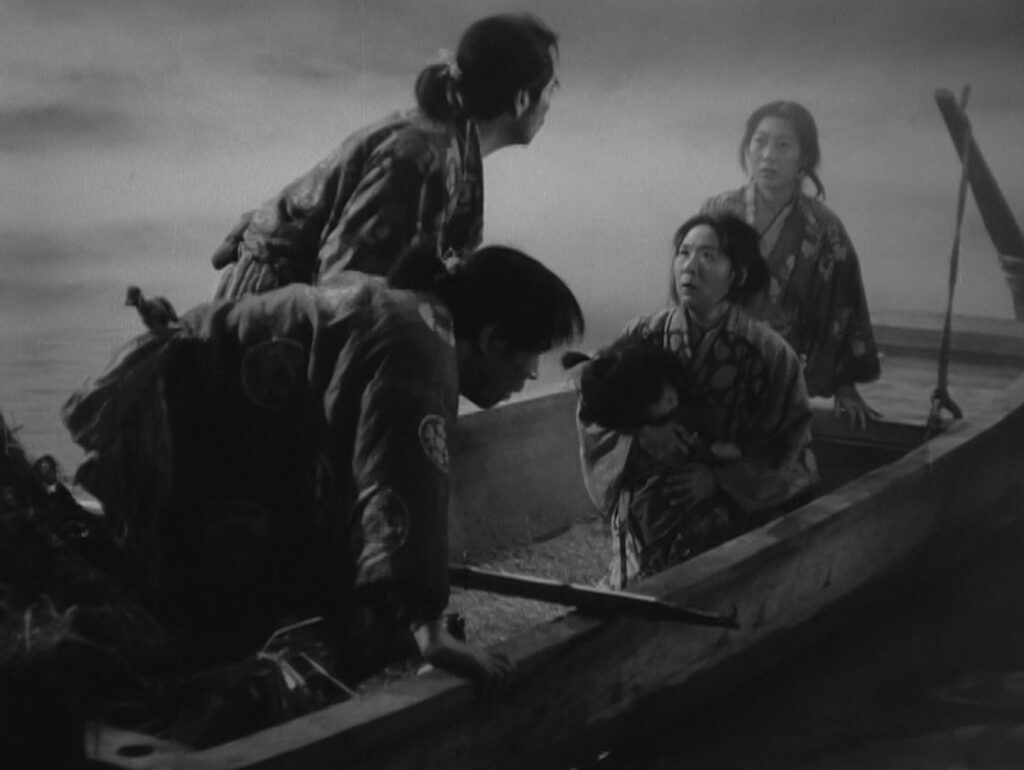
An excess of enthusiasm unites both stories. Tobei is so hellbent on becoming a samurai that he neglects his wife, leaving her prey to rape and prostitution. Genjuro is equally overenthusiastic, but the object of his zeal shifts from his pottery to his romance with Lady Wakasa. Like Tobei he neglects his wife, leaving her alone to be killed by soldiers from the losing army. The women suffer while the men learn lessons. By the end, each husband has tempered his enthusiasm and is ready to settle into a realistic way of life. By stressing this excess of enthusiasm in both stories, Ugetsu warns Japanese viewers that it’s not enough to channel their wartime fanaticism into commerce. Instead they must learn to calm their fanatical impulses.
Each of Ugetsu‘s twin threads is thus split between a male and a female point of view. These are only two of many doublings. There are two murders with a spear in close succession (Miyagi, and the executioner of the general whose head Tobei brings to the warlord); two coin-filled purses that stand for Ohama’s defiling (one after her rape, one in the brothel); and two trick shots that create a magical continuity with a moving camera (the transition from the hot springs to the lakeside, and Miyagi’s reappearance at Genjuro’s homecoming). The two couples represent two types of ambition and two responses to it, and each suffers a trauma (Miyagi’s death and Ohama’s rape). Miyagi’s ghost is a symmetrical counterpart to Lady Wakasa – Genjuro goes from one ghost to another, from a mistress to his wife, from an elusive ideal who distracts him from his life’s purpose, to a living memory whose spirit sets him back on course.
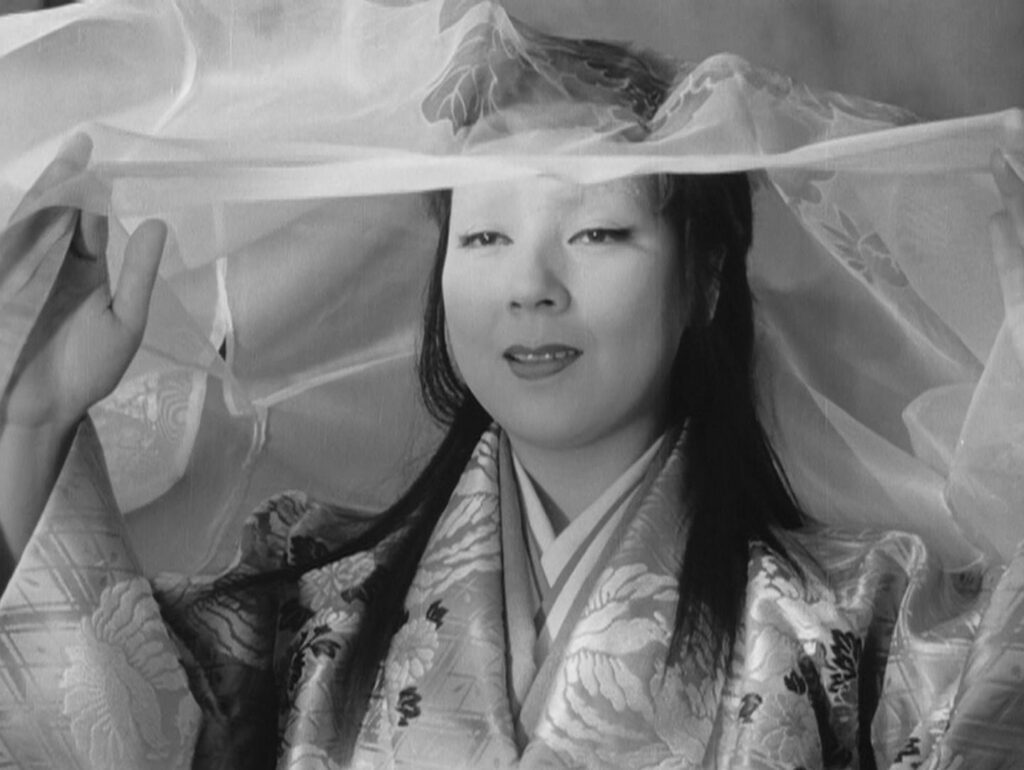
The most suggestive doubling is the pair of camera movements that bracket Ugetsu, each showing the same pastoral landscape with fields, a hut, and a small half-quarried hill. The opening shot is a slow right-to-left pan, whereas the closing shot rises above Miyagi’s grave, the crane shot offset from the opening pan by 90º. If the opening horizontal movement represented linear narrative time, the vertical movement simulates Miyagi’s spirit rising from her grave – a direction of time that we can call “eternity”. The final shot is stable and enduring, in contrast to the turbulence the characters have just lived through and which Japan had recently experienced during the war.
The idea of the eternal is not that history will stop, but that Genjuro – or anyone else – can find peace and meaning by living for something unchanging. Genjuro lives for the memory of Miyagi and becomes the man she had hoped for. The closing shot rises over past and future generations, Miyagi’s grave and her little boy. By looking always to the past and future at the same time, Ugetsu has been preparing us all along to appreciate this ending, which puts past and future into an all-encompassing perspective.
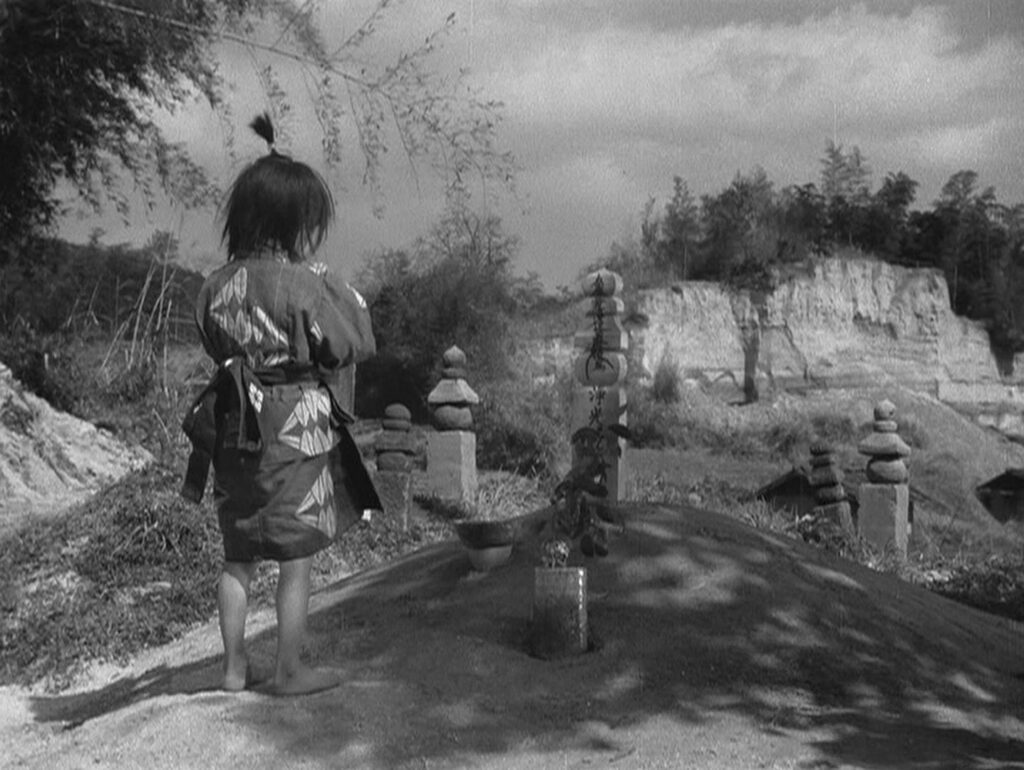
Japan’s transition from a destructive imperial nation to a prosperous liberal nation took only a few years, and in 1953 the direction of its transformation was evident. It’s surely not a complete accident that that year produced two enduring classics of Japanese cinema, both of which look forward and backward in time simultaneously, both of which define the difference between time and the eternal, and both of which use a moving camera to create an important structural marker with a change of direction. In Ugetsu the defining camera movements bracket the whole film at its two ends, but in Tokyo Story they bracket a short scene in the middle. It’s not only that Japan itself was changing direction, but that its people were ready to look at the flow of life from a broader point of view.
CONNECTIONS:
Sunrise – Bracketed by horizontal and vertical movement representing time and eternity; rural and city scenes bridged by boat rides
Vampyr – Adaptation from two separate short stories
The Wizard of Oz – Character who learns to value home and character(s) who find missing piece
Tokyo Story – Framed by time and eternity; looking backward and forward in time; story of elemental and universal values; structural significance in the direction of camera movement; made in the same year
Wild Strawberries – Bracketed by expressions of linear time and eternity
La notte – Bracketed by camera motions 90° to each other
Cléo from 5 to 7 – Begins with linear time, ends with timelessness
La rupture – Framed by horizontal and vertical movements
Cries and Whispers – Begins with linear time, ends with a vision of eternal time
Where Is My Friend’s Home? – Character(s) backtrack in the midst of a journey